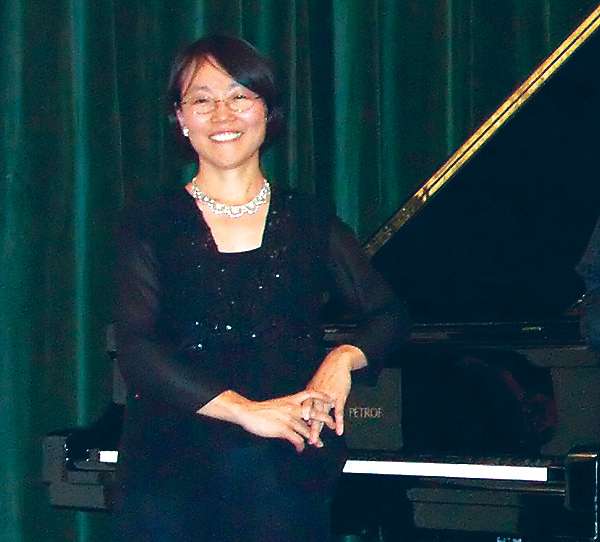|
Back
Victory of Four Czech Mates New York
Bohemian National Hall
02/25/2013 -
Bohuslav Martinu: Piano Quintet No. 0, H. 35 (US premiere) – Piano Quintet No. 2, H. 298
Vitezslav Novák: String Quartet in D
Michiko Otaki (Piano), Graffe String Quartet: Stěpán Graffe, Lukás Bednarík (Violins), Lukás Cybulski (Viola), Michal Hreno (Cello)

M. Hreno, L. Cybulski, L. Bednarík, S. Graffe
(© graffequartet.unas.cz)
Three 20th Century musical artists were not so much composer as fountains, from which notes sprayed forth, seemingly without effort, without ceasing. The Provencal Darius Milhaud, the Brazilian Heitor Villa-Lobos, and the Czech Bohuslav Martinu simply couldn’t stop writing. And while none of them would boast that their compositions were all the same level, they all had more than a few masterworks.
One of those masterworks, Martinu’s Second String Quintet was played last night, appropriately at the building which started in 1896 as the “Bohemian Benevolent & Literary Association” and today is a monument to New York’s ethnic community halls. Equally appropriate, the Quintet was performed by the Graffe String Quartet, winner of the Czech Chamber Music Society Prize, with two other works from their country, augmented by the American pianist Michiko Otaki.
But it was this Second Quintet, written in 1944, which was the cynosure of the evening. And–with Julietta, The Frescoes of Piero della Francesca, a few symphonies, and the piano and violin Concertos–part of the codex of masterworks by this most prodigious composer.
The Graffe Quartet made appropriately Elysian music here. Martinu was living in America in 1944, always painfully in need of money. But this Quintet was composed with such high spirits that one feels the composer was back in his rural homeland. True, his unique cadences and harmonies could only be those of Martinu. But here, his ebullience was inspired from the first hazy measures–in three bars, coming from chaos to song–to the fast-slow major-minor games in the last movement.
Even the Adagio, a tempo for which Martinu could provide very doleful sounds, here was a sweet lyrical flowering of songs and tones, these tones reflected and taking root from their own notes, almost like a Bohemian Philip Glass.

M. Otaki (© Lukás Bednarík)
As a quintet, the four players of the Graffe Quartet played obviously for the sheer adoration of the piece, ending with a wickedly eccentric flourish. But Ms. Otaki, who has recorded with the group, had a cadenza in the finale which, like the music of the four male players, was syncopated, balanced, played for the sheer beauty with which Martinu could animate his most inspired creations.
Not that Martinu was perfect by any means. The focus of the evening was an American premiere of an unfinished quintet which Martinu had composed when he was 21 years old. It had been hidden away for almost a century, until the Graffe Quartet was asked by the Martinu Society in the Czech Republic, to reassemble some apparently almost illegible pages. About half was in fairly good condition, but another half was “scribbles,” explained Ms. Otaki.
“In fact,” she said, “the only way we could make sense of that part of the music was through trial and error.”
The five musicians did a good job of it. The first movement was incontestably that of Martinu in harmony and syncopation. He didn’t attempt to hide the folk song quality of the first theme, which gave it an added charm. The second theme was more lyrical, more conservative, but both themes and their sudden modulations to alien keys were striking.
The second movement was less original. In fact (and this is no criticism), much sounded like a late chamber piece by Antonín Dvorák. By eschewing his original conception, it was less Martinu, but it still possessed that amiability, those sudden wisps of inspiration and the delight of music making itself.
The Graffe Quartet also played a two-movement Quartet by Vitezslav Novák, who is famed in his native country. Unlike Josef Suk, Martinu and Janácek. Though, his earnest, well-composed work was never heard by this listener before, and probably won’t be again.
In form, it was original, starting with a very long fugue, and ending with a freely-composed “Fantasia” The fugue was at times academic but was indeed constructed (very consciously constructed) to an emotional apex of sorts. The “Fantasia” was very long, very sincere, played with tremendous enthusiasm by the Graffe Quartet. I could have made the effort and tried to follow Novák’s complex structure, but frankly the material didn’t lend itself to much thought.
This was serious music indeed, and Mr. Novák obviously plumbed deep to give it the right gravitas. Which was why it was such a relief to hear Martinu’s Quintet, which soared and stirred and provided such an enchanting ending to the evening.
Harry Rolnick
|